Main events of the week[1]
|
The international campaign against ISIS
US and coalition airstrikes
- This week, the US and coalition forces continued their airstrikes against ISIS targets. During the week, dozens of airstrikes were carried out in Syria and Iraq. Following are the main airstrikes (CENTCOM website):
- Syria– the airstrikes were concentrated in the provinces of Al-Hasakah, Aleppo, Al-Raqqah and Kobani. The airstrikes targeted ISIS tactical units, battle positions, vehicles, and a tank.
- Iraq– the airstrikes were concentrated in the areas of Al-Assad, Baiji, Fallujah, Mosul, Ramadi, Sinjar, Tal Afar and Hawija. The airstrikes targeted ISIS tactical units, buildings, firing positions, weapons, vehicles and heavy machinery.
- Brig. Gen. Thomas D. Weidley, chief of staff for Combined Joint Task Force Operation Inherent Resolve (the name of the international campaign fighting ISIS), said at a briefing for journalists that the strategy of the coalition countries and Iraq was working and “our campaign is on track.” He mentioned two combat zones in Iraq (US Department of State website, May 15, 2015):
- Baiji and its oil refineries – according to Weidley, the situation is still unclear, but Iraqi forces are constantly working to improve their positions. Since the liberation of the city of Tikrit in early April 2015, the coalition forces have carried out 176 airstrikes in and around Baiji, destroyed numerous battle positions and weapons, and killed many of ISIS’s operatives. He said that since the beginning of the campaign against ISIS around eight months ago, the coalition forces carried out 330 airstrikes in and around Baiji.
- The city of Ramadi – Regarding ISIS’s successful takeover of most of the city of Ramadi, he said that ISIS’s achievements were not indicative of a defeat on the part of Iraq’s military forces, since ISIS’s success was temporary.
|
In the ITIC’s assessment, Thomas Weidley’s remarks reflect excessive optimism on the part of the US Army with regard to the Iraqi Army’s condition and capabilities. At the oil refineries in Baiji, ISIS operatives managed to take control of large parts of the compound, despite extensive US air support. ISIS’s successful takeover of the city of Ramadi, and the fact that the Iraqi Army fled from the city, represent an achievement for ISIS which, in the ITIC’s assessment, has both military implications and implications in terms of morale (to be described below). Moreover, in the ITIC’s assessment, the latest developments in Iraq indicate a fundamental problem in the Iraqi Army’s capability and its ability to fulfill the far-reaching expectations on the part of the US and the coalition (the takeover of Mosul). |
Main developments in Syria
Idlib province
- nIn the Idlib province, in northwestern Syria, battles continued between the Syrian Army, which is supported by Hezbollah, and the Al-Nusra Front and its allies (Jaysh al-Fatah). The Al-Nusra Front and its allies are striving to take over the road from Idlib to Latakia on the coastal plain. The Syrian forces and Hezbollah are trying to defend cities and villages along the road and dominant places (such as Mount Nabi Younes). In the city of Jisr al-Shughur, the Syrian force trapped in the hospital in the southwest of the city is still hanging on. If this effort by the Al-Nusra Front and its allies succeeds, this will pose a significant threat to the Syrian regime’s strongholds in Latakia and along the coastal plain.
- According to a report from May 12, 2015, the Al-Nusra Front and its allies launched an attack to take over of the city of Ariha, south of Idlib(Al-Sharq Al-Awsat, May 13, 2015). On May 14, 2015, the Al-Nusra Front uploaded a video claiming that thevillage of Musaybin, south of Idlib, is under its control. According to the Al-Nusra Front, a number of combatants from Lebanon and Iran were killed in the battle that took place in the village. They had been fighting alongside Syrian forces that retreated toward the city of Ariha (about 14 km south of Idlib). According to the Al-Nusra Front’s spokesman, its next goal is to take over the city of Ariha (Al-Nusra Front–affiliatedTwitter account, 14 May 2015; justpaste.it, May 14, 2015).
- On May 19, 2015, opposition sources reported that the Al-Nusra Front and its allies managed to take over the army camp in Mastouma (south of Idlib, one of the last strongholds of the Syrian Army in the region) and the Mastouma-Ariha highway. It was also reported that the Syrian regime’s forces withdrew to Ariha (Al-Arabiya al-Hadath, May 19, 2015).
- In the city of Jisr al-Shughur, most of which is occupied by the Al-Nusra Front, the organization’s operatives displayed barrels which they claim were seized. These barrels contain equipment which, according to them, was parachuted by the Syrian regime’s Air Force to its men who are besieged in the National Hospital in Jisr al-Shughur (Al-Nusra Front-affiliated Twitter account, May 15, 2015).
Al-Qalamoun (the Syrian-Lebanese border)
|
- According to “Hezbollah sources,” in the battle in Al-Qalamoun, Hezbollah is using the advanced weapons at its disposal: UAVs equipped with laser-guided missiles, artillery, surface-to-air missiles and more. Hezbollah is also carrying out attacks behind enemy lines, employing wiretapping and electronic weapons. According to Hezbollah sources, the use of these tactics with these weapons is a signal to Israel regarding Hezbollah’s capabilities in a future campaign against it in the Galilee, an area whose conditions are allegedly similar to the battle zone in Al-Qalamoun (Al-Rai, May 14, 2015).
- Commenting on the campaign in Al-Qalamoun, Hezbollah leader Hassan Nasrallah said that Hezbollah had been successful even though the campaign was still ongoing. According to him, the Al-Nusra Front operatives and their allies were driven out of the area captured by Hezbollah, and Syria regained control of around 300 square kilometers. According to Nasrallah, training camps and workshops for making car bombs were destroyed, and territorial continuity was created between Syria and Lebanon. Nasrallah stressed Hezbollah’s military strength and the assistance that it provides to the Syrian Army. However, he said, as long as there are armed groups in the suburbs of the Lebanese city of Arsal in the northern Bekaa Valley, and in the northern Al-Qalamoun Mountains, absolute security will not prevail in Lebanon (Al-Manar TV, May 16, 2015).
- In his speech, Hassan Nasrallah claimed that up to now, Hezbollah had lost 13 operatives in the battles against the Al-Nusra Front and its allies. The ITIC believes that the actual figure is higher. The South Lebanon news website published a death notice for 26 Hezbollah operatives killed between May 1-15, 2015. The notice included photos of the operatives who were killed “while carrying out their jihadi duty”. In light of the dates when the operatives were killed, it is likely that most of them were killed in the campaign in Al-Qalamoun. Moreover, there have been recent reports in the Arab media stating that residents in South Lebanon and the northern Bekaa Valley recently reported many funerals of Hezbollah operatives who were killed in the fighting in Al-Qalamoun (Al-Quds al-Arabi, May 12, 2015). Sources in Beirut said that Hezbollah was ordered to conceal the large number of fatalities and publish the names gradually in the media (Okaz, May 16, 2015).
Al-Hasakah province
- In the Al-Hasakah province, Kurdish YPG fighters managed to take control of the road between the cities of Al-Hasakah and Kobani, which is under their control (see map). The Kurds, supported by coalition force airstrikes, are also managing to advance towards the town of Mabruka, ISIS’s last stronghold between Ras Al-Ayn and Al-Raqqah (Al-Akhbar, May 14, 2015). In the ITIC’s assessment, the Kurdish forces are striving to create territorial contiguity between the areas under their control in Al-Hasakah and Kobani (Ayn al-Arab).
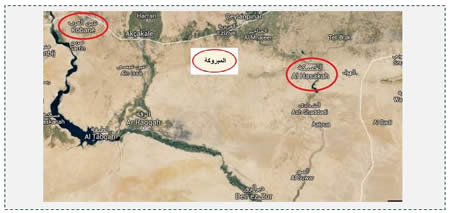
The area between the Kurdish cities of Al-Hasakah and Kobani, with the town of Mabruka, ISIS’s stronghold, in the middle (Google Maps, May 2, 2015)
Deir al-Zor province (called Wilayat al-Khayr by ISIS)
ISIS’s activity in and around the city of Deir al-Zor
On May 15, 2015, ISIS published a video issued by the information office of Deir al-Zor province, claiming the ISIS operatives had taken over Saker Island, located between the two tributaries of the Euphrates (about 5 km southeast of Deir al-Zor). The takeover of the island brings ISIS operatives closer to the Deir al-Zor airfield, which is still controlled by the Syrian regime.One of the speakers in the video expressed ISIS’s determination to “liberate” the province from the “contamination of the Syrian regime and its followers” (Isdarat al-Dawla al-Islamiyya, May 15, 2015).
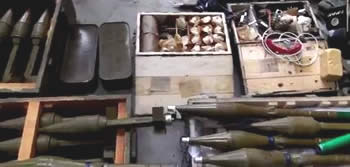
Weapons that fell into the hands of ISIS operatives who took over Saker Island (Isdarat al-Dawla al-Islamiyya, May 15, 2015)
Senior ISIS operative killed in a US Army ground operation
- On the night of May 15-16, 2015, US Army Special Forces raided a target in the village of Al-Amr (about 30 km southeast of Deir al-Zor). At the end of a gunfight, they killed senior ISIS operative Abu Sayyaf, described as the “oil and gas emir” of ISIS. More than ten of his men were killed along with him. Abu Sayyaf’s wife, Umm Sayyaf, was taken prisoner, and a young Yazidi woman, who had served as a slave, was questioned and released. No casualties were reported among the US military.
- Senior US officials said that the killing of Abu Sayyaf was a major blow for ISIS. According to the Americans, the operative who was killed was of great importance, because he was involved in ISIS’s military operations and helped manage its activities in the areas of oil, gas and money. The raid was preceded by several weeks of monitoring the operative by collecting intelligence about him obtained from various sources (CNN, Fox News, May 17, 2015). Steve Warren, spokesman for the US Department of Defense, said that they believed that Abu Sayyaf had been involved in planning operations and that killing him would undermine ISIS’s ability to plan future operations. He also said that following the killing, the US would have a deeper understanding of ISIS’s structure and financing methods (CENTCOM website, May 19, 2015).
|
This is the first successful ground operation carried out by the Special Forces of the US Army since the US began its campaign against ISIS. Previous operations carried out or attempted by the US Army in Syria (and Yemen) were intended to release American hostages and ended in failure. In spite of the propaganda and morale value of the successful operation, the ITIC believes from an overall perspective, it is of limited significance. This is because the success of the campaign against ISIS depends, first and foremost, on the effectiveness of the local ground forces, while the coalition airstrikes and commando operations are only a supporting factor. |
Homs province
- On May 13, 2015, ISIS operatives took over most of the city of Al-Sukhnah, located in the Syrian Desert in the eastern part of the Homs province. The city of Al-Sukhnah is the second largest city in the Syrian Desert, after Palmyra, and is located in the middle of the road linking Palmyra and Deir al-Zor. After making rapid progress in the desert terrain, ISIS operatives attacked the city of Palmyra with rocket fire and managed to take over most of the northern neighborhoods of the city, the officers’ quarters, and the armories. According to sources within ISIS, only two parts of the city remain under the control of the Syrian Army (All4Syria, May 16, 2015). One day later, on May 14, 2015, ISIS operatives took over large parts of the Al-Hail and Arak gas fields northeast of the city of Palmyra (at a distance of 25 and 40 km from the city). These fields are vital to the residents of Palmyra, since they supply its electricity.
- Syrian Army forces reportedly carried out a counterattack, forcing the ISIS operatives to withdraw from the northern neighborhoods of Palmyra.However, ISIS operatives are still occupying villages north of the city, as well as the gas fields (syriahr.com, May 17, 2015; Al-Mayadeen, May 18, 2015). The Syrian Observatory for Human Rights (SOHR) reported that on May 15, 2015, 23 people were executed in Palmyra, including nine minors and five women. It is also reported that more than three hundred people were killed in the fighting in the city.
- According to a report from May 19, 2015, the Syrian Army managed to take over the “Assad checkpoint” located west of Palmyra, while the area of Al-Amariya, north of the city, is still controlled by ISIS. Many civilians have fled from the northern neighborhoods controlled by ISIS to areas controlled by the Syrian Army (Al-Akhbar, May 19, 2015).
|
ISIS’s attack on Palmyra threatens an important archaeological site, the remains of the ancient city of Palmyra. This city is located in an oasis, and was an important caravan stop on the international trade routes. In 1980, the city was declared a World Heritage Site by UNESCO. In 2013, following the civil war, the city was declared a site at risk. If ISIS operatives manage to take over the city, they are liable to destroy the archaeological sites located there, as they did in Iraq.
|
Main developments in Iraq
Al-Anbar province
The city of Ramadi
- On May 15, 2015, ISIS operatives took over the government buildings and most of the neighborhoods in the city of Ramadi, capital of the Al-Anbar province.The attack began with the detonation of car bombs near the headquarters of the Iraqi forces, following which ISIS operatives broke into the compound. ISIS operatives carried out another attack against an army base in the western part of the city and then took over the entire city. Iraqi Army forces withdrew from the area. According to Iraqi officials, although there are still several pockets of resistance in the city, from a military standpoint the city has fallen and the Iraqi security forces there have collapsed. It is estimated that around 500 people were killed in the fighting (BBC, May 18, 2015). Tens of thousands of civilians fled from the city (Al-Jazeera TV, May 19, 2015).
- One of ISIS’s media arms announced that ISIS had managed to take over the entire city. ISIS posted videos from Ramadi which it claims indicate its control over the city (Aamaq, May 16-17, 2015).
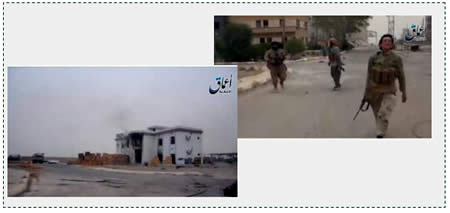
Left: Building on fire in Ramadi. Right: ISIS operatives in Ramadi (Aamaq, May 17, 2015)
|
The city of Ramadi, located about 100 km from the capital Baghdad, is the capital of the large Sunni province of Al-Anbar, ISIS’s stronghold in Iraq. ISIS now controls most of the province, but there still remain a number of isolated “pockets” controlled by the Iraqi Army (Habbaniyah, Al-Assad Airport, and the cities of Al-Baghdadi and Haditha).[2] The takeover of Ramadi threatens the city of Habbaniyah (which is near an Iraqi Army base and an airport), which is located between Ramadi and Fallujah (two cities under ISIS’s control). Moreover, the collapse of the Iraqi Army in Ramadi indicates the shortcomings in its fighting abilities (despite US support). For ISIS, which has set its sights on Baghdad (as recently declared its leader Al-Baghdadi), it represents both a military achievement and an achievement in the battle for hearts and minds. |
Fallujah
- ISIS’s media arm issued a video documenting ISIS operatives fighting against Iraqi Army forces located south of the city of Fallujah (Aamaq, May 17, 2015).
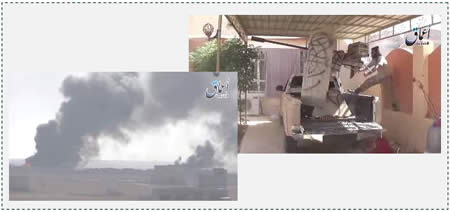
Left: Smoke rising from the area where Iraqi soldiers are staying, probably following a suicide bombing attack. Right: Machine gun fire at the scene of the fighting south of Fallujah (Aamaq, May 17, 2015)
ISIS’s attack on Zoba (between Fallujah and Baghdad)
- A video posted by ISIS documents an attack carried out by ISIS operatives on the town of Zoba (between Baghdad and Fallujah). The video shows the takeover of an Iraqi Army base and the killing of Iraqi soldiers at the base. The video also shows prisoners who were beheaded, and weapons that were captured from the Iraqi Army (Isdarat al-Dawla al-Islamiyya, May 16, 2015)
Samarra
- On May 17, 2015, ISIS issued a video documenting its operatives fighting against an Iraqi Army outpost on the outskirts of the city of Samarra, north of Baghdad. The video shows ISIS operatives taking over the outpost and blowing up its main building (Isdarat al-Dawla al-Islamiyya, May 17, 2015)
Nineveh province
- According to reports, ISIS operative Abd al-Rahman Mustafa, AKA Abu Alaa al-Afri, was killed in an airstrike by the coalition forces in Tal Afar, west of Mosul. It was also reported that Al-Afri served as Abu Bakr al-Baghdadi’s deputy and that he was the one who replaced al-Baghdadi after the latter was injured. Akram Qirbash, the supreme judge of the Sharia court in the Nineveh province, and additional senior ISIS operatives were also killed in the airstrike (Ilaf, May 13, 2015). The Iraqi Defense Ministry said that the US Department of Defense had announced that the report was unconfirmed (Facebook page of the Iraqi Defense Ministry, May 13, 2015).
The conduct of the Islamic State
ISIS leader Abu Bakr al-Baghdadi’s speech
- On May 14, 2015, an ISIS-affiliated forum posted an audiotape of a speech by ISIS leader Abu Bakr al-Baghdadi. The speech was translated into several languages. In the tape, Al-Baghdadi calls on all Muslims to immigrate to the Islamic State or to fight in the countries where they live, against the Crusaders (i.e., Christians), Jews and infidels. He attacks the Saudi government, which he claims serves the Jews and the Crusaders.
- He calls on Muslim refugees who fled from the territories controlled by the Islamic State to return to it, guaranteeing that ISIS will protect them. Al-Baghdadi praises the achievements of his operatives during the battles and states that ISIS’s next targets are Baghdad and Karbala, a Shiite holy city in Iraq.He also praises the ISIS operatives in the Sinai Peninsula, saying that he looks forward to seeing them soon in Jerusalem (ISIS-affiliated forum, May 14, 2015).
|
The audiotape was released after around six months in which no public speech of Al-Baghdadi was published. It is possible that the speech was published in order to refute media reports that Abu Bakr al-Baghdadi was mortally wounded in an airstrike by the coalition forces. Al-Baghdadi’s praise of the ISIS operatives in the Sinai Peninsula may indicate the special importance that ISIS attaches to this branch, particularly in view of its resistance to the attacks by the Egyptian Army and possibly also in view of its potential terrorism against Israel. |
ISIS training camp for children in the Damascus area
- One of ISIS’s media arms issued a video documenting an ISIS training camp in the Damascus province. The video shows the course graduation ceremony of a group of ISIS operatives (Isdarat al-Dawla al-Islamiyya, May 17, 2015)
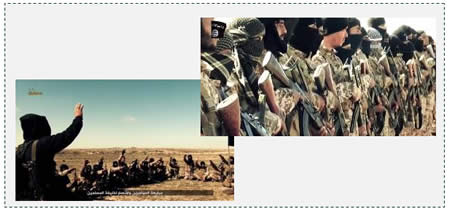
Left: The course graduates’ pledge of allegiance to Abu Bakr al-Baghdadi. Right: Some of the course graduates (Isdarat al-Dawla al-Islamiyya, May 17, 2015)
Egypt and the Sinai Peninsula
Egyptian security activity
- The Egyptian security forces continued their intensive security operations against the jihadists in the Sinai Peninsula, including airstrikes.A few dozen terrorist operatives were killed by the security forces. In addition, many operatives were detained. According to Egyptian “security sources,” automatic weapons and walkie-talkies smuggled from the Gaza Strip to the Sinai Peninsula through a tunnel were found in the possession of the Ansar Bayt al-Maqdis operatives who were killed (ONE, May 12, 2015). The Egyptian forces also reported that they had foiled the smuggling of weapons from the Gaza Strip to northern Sinai through tunnels in Rafah (Al-Masry al-Youm, May 13, 2015).
Jihadi activity
- On the other hand, jihadi activity against the Egyptian security forces in the northern Sinai Peninsula continued. Here are some of the operations:
- On May 12, 2015, a team of Egyptian sappers neutralized six of seven IEDs that were buried in the Rafah area and intended for use against the Egyptian forces. Two Egyptian officers and two soldiers were killed by the explosion of the seventh IED (Al-Youm al-Sabea, May 13, 2015).
- On May 12, 2015, an attempted attack on an Egyptian Army checkpoint in Sheikh Zuweid was foiled, when several gunmen in vehicles and motorcycles tried to fire at the checkpoint. Two operatives were killed and the rest fled (Al-Masry al-Youm, May 12, 2015).
- On May 15, 2015, two motorcyclists fired RPG rockets at a North Sinai province government building in Al-Arish.The two motorcyclists fled the scene. There were no casualties (Al-Masry al-Youm, May 15, 2015).
- On May 16, 2015, Ansar Bayt al-Maqdis claimed responsibility for killing three judges and a driver and injuring a number of other people (Al-Youm al-Sabea, May 16, 2015).After the killing of the judges, an airstrike was carried out by the Egyptian Army, in which seven Ansar Bayt al-Maqdis operatives were killed (Al-Youm al-Sabea, May 16, 2015).
|
In another announcement released by ISIS, claiming responsibility for the killing of the three judges, the organization declared total war against the Egyptian justice system. According to the announcement, this is because it denies religious law and is a tool of the “Christian Zionist regime” and a weapon used by the regime to eliminate jihadi operatives. According to the announcement, from now on judges, representatives of the prosecutor’s office, legal advisors, court employees and their families and others associated with the Egyptian justice system would be targeted by ISIS (file sharing website, May 18, 2015). |
Propaganda activity by Ansar Bayt al-Maqdis (ISIS’s branch in the Sinai Peninsula)
- On a forum affiliated with Ansar Bayt al-Maqdis, the organization posted a video showing, among other things, its operatives attacking an Egyptian post. The video documents the operatives’ preparations for the attack and the attack itself. One of the operatives addresses the President of Egypt and promises him that his men “will surprise him and crush his soldiers.” The video includes photos of Egyptian soldiers who were killed, wounded soldiers being evacuated by ambulance, and a building being blown up by a truck bomb driven by a suicide bomber (jihadi forum, May 12, 2015).
- On May 14, 2015, another video was posted, documenting attacks by Ansar Bayt al-Maqdis against the Egyptian security forces. Among other things, the video shows an attack on a military checkpoint in northern Sinai and an attack on a police station in Al-Arish. The video also shows the abduction of an Egyptian soldier and the seizure of weapons and an APC belonging to the Egyptian security forces. ISIS threatened to continue to attack the security apparatuses in Egypt (masry.web.tv file sharing website, May 14, 2015).
Counterterrorism and preventive activity
n At a meeting of NATO foreign ministers held in Turkey, Turkish Foreign Minister discussed the activity of the Turkish security forces against ISIS operatives who come to Turkey. According to the Turkish minister, operatives from ninety countries have tried to pass through Turkish territory on their way to join ISIS in Syria. He added that it was very difficult to monitor the border between Turkey and Syria. He said that so far, Turkey had denied entry to 13,800 suspicious people. According to him, Turkey is the only country, among the countries of the international coalition, which has a common border with ISIS, and this poses a serious threat to Turkey (Hürriyet, May 13, 2015).
The global jihad in other countries
Libya
- Abdul Basit Haroun, adviser to the Libyan government's intelligence service, said that ISIS employed vessels used to smuggle migrants from Libya to European countries as a means for sending ISIS operatives to Europe. According to Haroun, ISIS earns millions of dollars from taking part in the networks that smuggle migrants to Europe, and these funds are used for terrorist activities (http://www.tahrirnews.com, May 17, 2015).
- ISIS’s branch in Libya beheaded two opposition operatives belonging to the Hawara Rebel Battalion [Katibat Thuwwar Hawara]. It is a network operating in the area of the village of Hawara, in eastern Sirte.In the ITIC’s assessment, these are power struggles between ISIS and its opponents. In recent weeks, ISIS has been trying to expand its control beyond Sirte, but has encountered resistance from local residents and organizations (Al-Dostour, Egypt, May 15, 2015).
Yemen
- ISIS’s Sanaa province posted a video documenting two ISIS operatives on a motorcycle breaking into the government post office in the Sanaa province and shooting three people to death. The video claims that they were members of the Yemeni government’s general security forces. After the shooting, the shooters flee on their motorcycle (Isdarat al-Dawla al-Islamiyya, May 13, 2015).
Mali
- On May 14, 2015, Jama’at al-Mourabitin, a Salafist-jihadi terrorist organization operating in the Republic of Mali, West Africa, posted an audiotape. In the tape, a spokesman for the organization, speaking on behalf of the organization, pledges allegiance to ISIS leader Abu Bakr al-Baghdadi. In addition, the speaker calls on all jihadi organizations around the world to act the way his organization did and join ISIS and support the Islamic State that it founded (YouTube and Twitter account, May 14, 2015).
- Two days later, senior operatives in the organization published a denial in which the organization’s leader, Mokhtar Belmokhtar, reaffirmed his allegiance to Al-Qaeda leader Ayman al-Zawahiri (Mauritania News Agency, May 16, 2015). These contradictory statements are apparently due to disputes or even a split in the organization, some of whose operatives identify with Al-Qaeda and some with ISIS (SITE website, May 15, 2015).
The United States
- Six Americans of Somali descent from Minnesota were detained after planning to go to Syria to fight alongside ISIS. The six were charged with planning to support terrorism. Four of them were detained in Minneapolis and two in San Diego after trying to buy fake passports in order to travel to Mexico and from there to Syria. A man by the name of Abdi Nur, who left the United States and went to Syria in May 2014, played a key role in recruiting the group (AFP, April 20, 2015).
Britain
- Threats by ISIS to carry out terrorist attacks in London have recently been posted on Twitter. The targets mentioned included key sites such as Covent Garden, Big Ben, the Tower of London and Paddington railway station. MI5 and Scotland Yard are investigating the matter but they do not believe that the threats are authentic, since they originated in Syria and not in Britain. All the accounts that published the threats have been suspended (Daily Telegraph, May 12, 2015).
The battle for hearts and minds conducted by ISIS
ISIS’s threats against Italy
- ISIS supporters posted a series of photos on Twitter, including photos from various cities in Europe, with a “zero hour” countdown. One of the posts, for example, which was written in Arabic, says “The Islamic State in Rome, wait for the zero hour.” Another post shows a photo of the cathedral in Milan and the city exhibition center. Most of the photos were taken from train stations throughout Italy (ibtimes.co.uk, May 18, 2015).
|
This is not the first time ISIS operatives have threatened the cities of Europe, and especially Rome, which ISIS perceives as a symbol of the Christian world. For example, on February 20, 2015, an ISIS-affiliated Twitter account published a poster showing the Colosseum in Rome. Alongside the photo it says in Arabic and Italian: “We will not stop fighting until we cry ‘Allah Akbar’ and sound the calls to prayer in Rome as conquerors, Allah willing.” The writer emphasized the word Rome (ISIS-affiliated forum, February 20, 2015) |
Threat of attacks by ISIS hackers on Western countries
- On May 15, 2015, the owner of an ISIS-affiliated Twitter account published a post claiming that hackers who support ISIS have declared electronic war on the US, Europe, Australia and other countries. He added that “this war has recently intensified” (ISIS-affiliated Twitter account, May 14, 2015).

The hacker threat (ISIS-affiliated Twitter account, May 14, 2015)
[1]Following the ITIC’s study on ISIS, from now on a weekly publication will be issued by the name of Spotlight on Global Jihad. The publication will monitor developments at ISIS and additional global jihad organizations and will focus on developments in the Middle East. We welcome comments from readers.
[2]According to Arabic-language daily Al-Sharq Al-Awsat, the Iraqi Army’s control is now limited to just five cities out of the 41 cities in the Al-Anbar province: Habbaniyah, Al-Baghdadi (including the Al-Assad camp), Haditha, Amiriyat al-Fallujah and An-Nukhayb (Al-Sharq Al-Awsat, May 18, 2015).











![ISIS-affiliated Twitter account: “Judges of the Egyptian Army of Apostasy killed by the Lions of the [Islamic] Caliphate in the Sinai provinc](https://www.terrorism-info.org.il//Data/articles/Art_20811/076_15_13_895256437.jpg)



